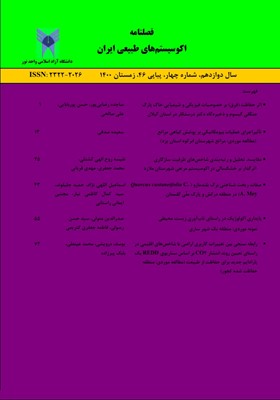پایداری اکولوژیک در راستای تابآوری زیست محیطی نمونه موردی: منطقه یک شهر ساری
محورهای موضوعی : جغرافیا
کلید واژه: توسعه پایدار, پایداری اکولوژیک, تابآوری زیست محیطی, منطقه یک شهر ساری,
چکیده مقاله :
تاب آوری اکولوژیک نقش بسیار مهمی را در افزایش ظرفیت تطبیقی و جلوگیری از پیامدهای منفی ناشی از تغییرات غیرقابل پیش بینی شهرها دارد. عوامل متعددی چون افزایش جمعیت،مدیریت ناکارآمد وغیره کاهش کیفیت زیست پذیری مناطق شهری را بدنبال داشته است. شهر ساری نیز از این منظر بی تاثیر نمانده و خسارات زیادی را متحمل گشته است. پژوهش حاضر، با هدف پایداری اکولوژیک در راستای تاب آوری زیست محیطی بوده است. پژوهش حاضر از حیث هدف، کاربردی و از نظر ماهیت ، توصیفی – تحلیلی و میدانی می باشد که شیوه گردآوری داده ها، اسنادی، کتابخانه ای و میدانی بوده، همچنین به منظور گردآوری داده ها، از پرسشنامه محقق ساخته، استفاده شده است. نمونه آماری مشتمل بر 384 نفر از ساکنین منطقه یک شهر ساری به طور تصادفی انتخاب شدند. تعداد 23 شاخص تاب آوری شهری در قالب شاخص زیست محیطی، مورد بررسی قرار گرفتند. به منظور تجزیه و تحلیل داده ها از نرم افزار SPSS و LISREL که مبتنی بر معادلات ساختاری می باشد، استفاده شده است. با استفاده از آزمون بارهای عاملی، سنجه ها براساس درجه اهمیت و تأثیر گذاری اولویت بندی و خلاصه سازی شدند، و برای تهیه نقشه شاخصهای مؤثر، از مدل منطق فازی در قالب سیستم اطلاعات جغرافیایی GIS استفاده شده است. نتایج تحقیق حاکی از آن است که همه قسمتهای منطقه یک شهر ساری، تاب آور نیستند، به طوری که محلات شمالی در سطوح پایین تاب آوری و محلات میانی در سطوح متوسط و محلات جنوبی و جنوب شرقی در سطوح بالای تاب آوری قرار دارد. لذا عوامل مؤثر در این سطوح تاب آوری ناموزون در سطح منطقه یک به ترتیب اهمیت اولویت بندی شدند، به طوری که شاخص زیست محیطی با 2/46 درصد، در این تاب آوری نامتوازن سهیم بوده است که با ارائه پیشنهاداتی، بر تقویت شاخص های مؤثر براساس اولویت آنها، تأکید شد.
Ecological resilience plays a very important role in increasing adaptive capacity and preventing the negative consequences of unpredictable urban change. Numerous factors such as population growth, inefficient management, etc. have reduced the quality of life in urban areas. The city of Sari has not been ineffective from this perspective and has suffered a lot of damage. The present study aimed at ecological sustainability in terms of environmental resilience. The present research is applied in terms of purpose and descriptive-analytical and field in terms of nature. The method of data collection is documentary, library and field. Also, in order to collect data, a researcher-made questionnaire is used. Has been. The statistical sample consisting of 384 residents of area one of Sari city was randomly selected. 23 urban resilience indicators in the form of environmental indicators were examined. In order to analyze the data, SPSS and LISREL software, which is based on structural equations, were used. Using factor load tests, the metrics were prioritized and summarized based on their degree of importance and effectiveness, and a fuzzy logic model in the form of GIS was used to map the effective indicators. The results show that not all parts of the region of a city of Sari are resilient, so that the northern neighborhoods are at low levels of resilience and the middle neighborhoods are at medium levels and the southern and southeastern neighborhoods are at high levels of resilience. Therefore, the effective factors in these levels of unbalanced resilience in the level of region one were prioritized in order of importance, so that the environmental index with 46.2%, has contributed to this unbalanced resilience, which by presenting suggestions to strengthen the index. Effective ones were emphasized based on their priority.
_||_

